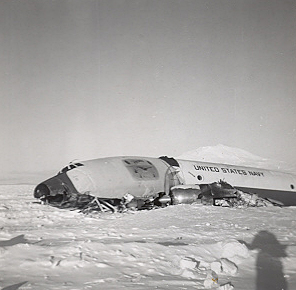

One of the pleasures of hosting this website is the very interesting emails I receive from folks all around the world. I recently received an email from Ricky DeRoo who had witnessed the crash landing of Navy WV-2 BuNo 126513 at Williams Field, McMurdo Sound, Antarctica on October 31, 1960. The aircraft was named “El Paisano” and was assigned to “Project Magnet” when it crashed enroute to Christchurch, New Zealand. I'd like to thank Ricky for sharing his fascinating story and photographs.
I was on stationed at NAF McMurdo Sound from September 1960 to August 1961. I was a Seabees electricians mate and was assigned on temporary duty to the NAF crash crew at Williams Field at McMurdo. The field was named after a Seabee heavy equipment operator who went through the ice in a D-8 tractor the previous year. Williams Field was, and I believe still is, the only ice runway in the world for wheeled aircraft. After the ice in the sound froze to a thickness of about 8 feet, a 10,000 foot north/south runway was scraped out on the ice. A special built rig called a “pulverizer” was towed up and down the runway creating gravel sized ice balls that allowed the wheeled aircraft to land, albeit not safely all the times, witnessed by many hairy landings! The depth of the sound under the runway was approximately 600 fathoms.
Aircraft routinely operating out of the field included C130’s, C124’s, P2V’s, R4D’s, R5D’s, R7V’s, and deHavilland Beavers. The ice stayed frozen most of the year until the ice breakers broke into the sound from the Ross Sea some 120 miles away. They started in October and arrived in the sound in November, followed by cargo transports and tankers to resupply the base. Air operations would cease, as the sound would break up rapidly. Minor air operations continued inland during the break up using ski-equipped C130’s, R4D’s, and P2V’s. The sound would start to freeze over again around January. The seasons in the Southern Hemisphere are opposite ours with the short summer in Antarctica lasting about 3-4 months.
I was on crash crew in a Snow Cat at the intersection of the runways at the time of the accident. The weather was clear, but there was a heavy wind (as usual) blowing up the runway causing a semi "whiteout" condition. The main runways were marked with 55 gallon drums painted black and, although we had ILS approach at the facility, the aircraft came in on a visual approach. She landed about 500 feet short of the runway threshold on about 5 feet of loose snow pack, tried to pull up, skipped over the threshold berm, dropped hard on the runway, collapsed the right main gear followed by the nose gear and started pirouetting towards us. Needless to say we abandoned the Snow Cat in hurry! We ducked as we ran with shrapnel from the break up flying all over the place! The plane crossed the intersection, went up over a snow berm and broke into three pieces.
There was complete silence for about 10-15 seconds and then the crew bolted through the openings like ants. They were all in shock and we had to chase some of them down the runway to stop them. We assisted the pilot and co-pilot out of the cockpit as they had sustained significant injuries. While the pilot suffered a broken back and the co pilot had serious face injuries, the flight engineer got out on his own. Avgas was leaking all over the place and if it had caught fire, there would have been little we could have done to put it out. We were equipped with a drum of pressurized dry chemical called Ansul, which had about a 40 second usage. The Connie had extensive electronic gear aboard and a Marine detachment was flown in to guard it while a special crew was flown from Christchurch to remove the equipment. We wondered if it was doing more than a magnetic survey of the earth, which is what we were told about the aircraft and crew’s mission! The sound opens up during the summer and the aircraft is currently sitting on the bottom of McMurdo Sound in approximately 600 fathoms of water. There is a current of about 15 knots flowing under the ice at all times.
Ricky DeRoo
October 2005
Photo Credits: Ricky DeRoo
Page Top Home
----Created 23 October 2005----